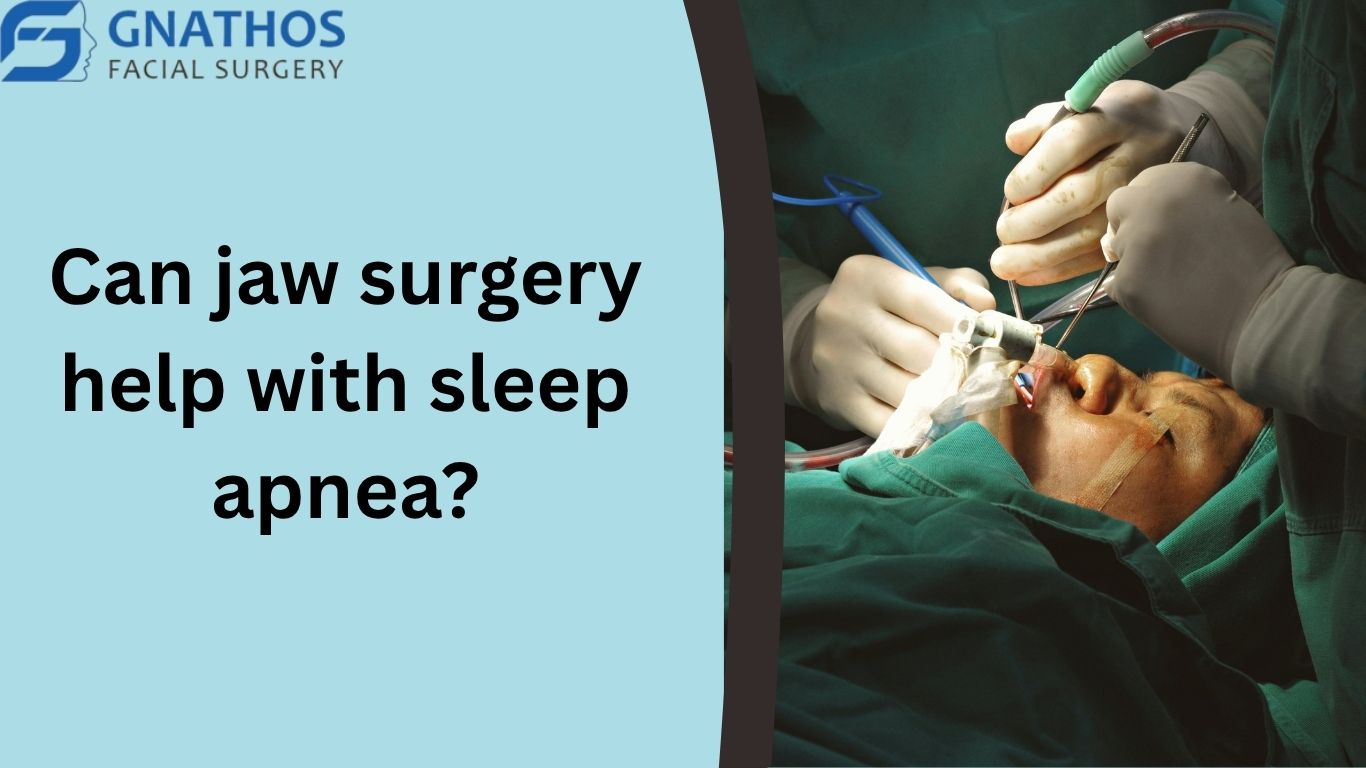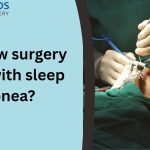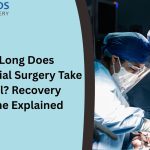If you or someone you love suffers from Obstructive Sleep Apnea (OSA), you know just how disruptive and serious this condition can be. The nightly struggle to breathe, the restless sleep, and the chronic fatigue that follows are taxing, and the long-term health risks—including heart disease, stroke, and high blood pressure—are a major concern.
You’ve probably explored all the common treatments: lifestyle changes, continuous positive airway pressure (CPAP) machines, and oral appliances. But if these haven’t provided the lasting relief you need, you might be looking into more definitive solutions and asking a critical question: “Can jaw surgery help with sleep apnea?“
The answer is a resounding “Yes,” and for many, it is the most effective, even curative, solution available. Jaw surgery, specifically Maxillomandibular Advancement (MMA), is a highly specialized procedure that directly addresses the root cause of the most severe forms of sleep apnea: a narrow or obstructed airway caused by skeletal structure. Today, we’re going to take a deep dive into this topic, explaining exactly why and can jaw surgery help with sleep apnea, how the procedure works, what the recovery entails, and when it’s the right choice for you. Let’s explore this powerful treatment option together.
Understanding Obstructive Sleep Apnea (OSA)
First, let’s briefly review what OSA is. It occurs when the muscles in the back of your throat relax too much during sleep, causing the soft palate, tonsils, and/or the tongue to collapse and completely block your airway. This blockage stops your breathing, often for ten seconds or more, leading to a drop in blood oxygen levels. Your brain then wakes you up just long enough to gasp for air, often without you even realizing you were awake.
Trouble Sleeping Due to Sleep Apnea?
Jaw misalignment can be a hidden cause of sleep apnea, leading to snoring and poor sleep quality. Discover how jaw surgery can open your airway and help you breathe—and sleep—better with our expert maxillofacial surgeons.
Book Your Sleep Apnea ConsultationCommon Treatments and Their Limitations:
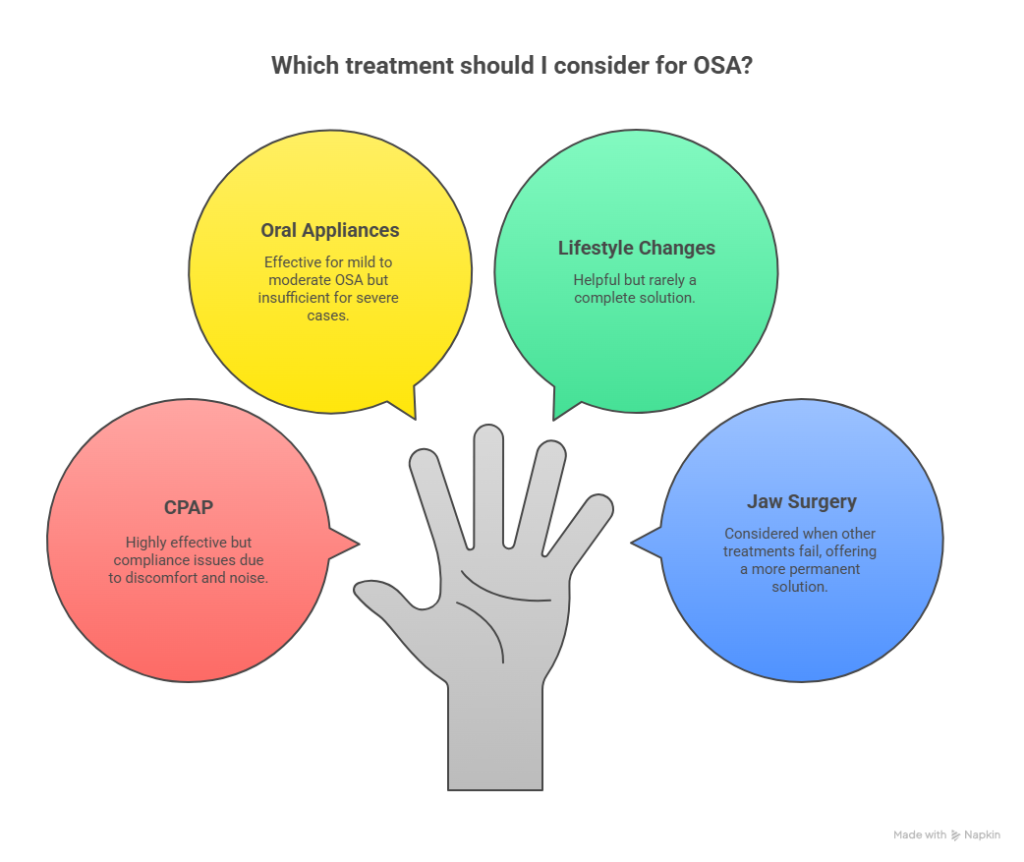
- CPAP (Continuous Positive Airway Pressure): The most common treatment. A machine delivers pressurized air through a mask to keep the airway open. It’s highly effective, but many people struggle with compliance due to the discomfort, noise, or bulkiness of the mask, rendering the treatment ineffective for them.
- Oral Appliances: Custom-fitted mouthpieces that move the lower jaw forward slightly to open the airway. They work well for mild to moderate OSA but are often insufficient for severe cases or for individuals with significant skeletal discrepancies.
- Lifestyle Changes: Weight loss and positional therapy (sleeping on your side) can help, but rarely solve the problem entirely on their own.
When these treatments fail or are poorly tolerated, the focus shifts to surgically enlarging the airway—and that’s where jaw surgery comes in.
Can Jaw Surgery Help with Sleep Apnea? The Mechanism of MMA
The specific jaw surgery used to treat OSA is called Maxillomandibular Advancement (MMA), or sometimes Bimaxillary Advancement. This procedure is a form of orthognathic surgery (corrective jaw surgery), and it’s a prime example of how surgically altering the facial skeleton can have profound, life-changing functional benefits.
The Problem: A Narrow Airway
In many people with severe OSA, the underlying issue isn’t just floppy tissue; it’s a structural deficiency. Their upper and/or lower jaw might be set back too far (retrognathia) or be underdeveloped. This means that the tongue, which anchors to the lower jaw, and the soft palate simply do not have enough forward space, causing them to collapse against the posterior pharyngeal wall (the back of the throat) when the patient lies down and the muscles relax.
The Solution: Expanding the Airway
MMA directly addresses this problem by physically moving the skeletal structures that support the airway forward.
- Advanced Maxilla (Upper Jaw): The surgeon performs a precise cut (osteotomy) on the upper jaw (maxilla).
- Advanced Mandible (Lower Jaw): A second osteotomy is performed on the lower jaw (mandible).
- Forward Movement: Both the upper and lower jaws are carefully and simultaneously moved forward, typically 10 to 12 millimeters or more, depending on the patient’s skeletal needs.
- Airway Expansion: Because the tongue and the soft palate are attached to the advanced jawbones, they are pulled forward with the bones. This immediately and significantly increases the volume of the upper airway space behind the tongue and soft palate, making it physically much more difficult for the tissues to collapse.
- Stabilization: The repositioned jaws are secured in their new, forward position using tiny titanium plates and screws.
The result of this surgical correction is a wider, more stable airway that remains open even when the throat muscles relax during sleep. This is why the answer to “can jaw surgery help with sleep apnea” is so definitive: it physically remodels the airway infrastructure.
Who is a Candidate for Maxillomandibular Advancement (MMA)?
MMA is not a first-line treatment, but it’s a highly successful one for carefully selected candidates. You are likely a good candidate if:
- You Have Severe OSA: You have a high Apnea-Hypopnea Index (AHI) and are at greater risk of health complications.
- CPAP Has Failed: You cannot tolerate the CPAP machine (non-compliance), or the machine is unable to adequately control your apnea events.
- Oral Appliance Ineffectiveness: Your condition is too severe for a mouthpiece to fully correct.
- Skeletal Deficiency: Imaging (like a lateral cephalogram or CBCT scan) confirms that your airway is narrowed due to a retruded or underdeveloped jaw structure.
- Good Health: You are medically stable enough to undergo a major surgical procedure.
The success rate of MMA is remarkably high, often cited as the most effective surgical treatment for OSA, with published success rates (AHI reduction) typically exceeding 90% and cure rates (AHI under 5) approaching 85-95% in ideal candidates.
The Recovery Journey: What to Expect
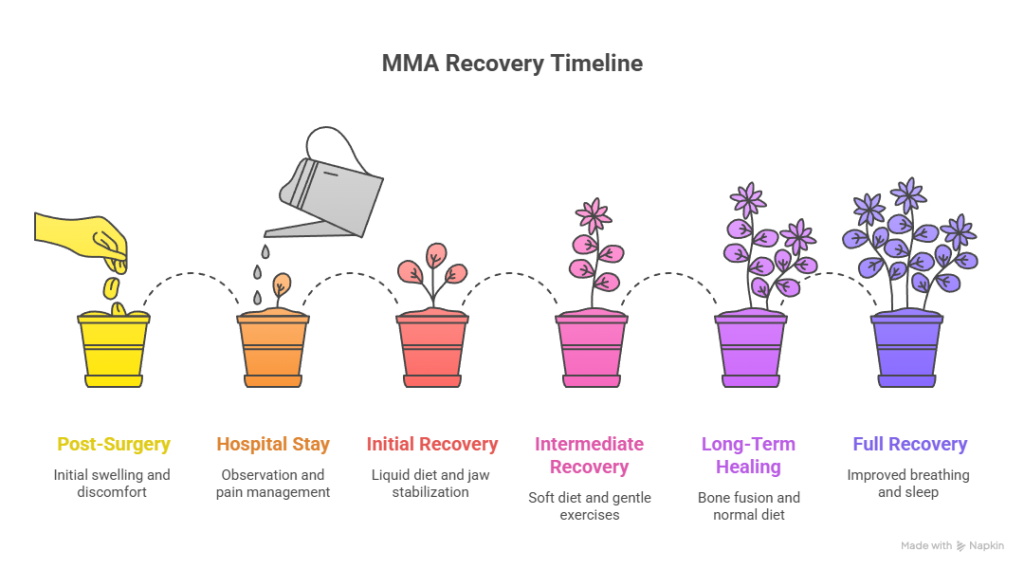
The recovery from MMA is the most challenging part of the process, as it is a major surgery. However, patients are often highly motivated due to the immediate improvement in breathing quality.
- Hospital Stay (1-3 Days): You will stay in the hospital for observation, pain management, and swelling control. The immediate improvement in breathing is often apparent in the recovery room.
- Initial Recovery (Weeks 1-3): This is the period of most intense swelling and discomfort. Your jaw will be stabilized with elastics or wires, meaning you will be on a liquid-only diet. You will need 2-4 weeks off work or school. Swelling peaks around day 3 and then begins a slow, steady reduction.
- Intermediate Recovery (Weeks 3-8): Swelling diminishes significantly, and you will transition from a liquid to a soft, non-chew diet. Your surgeon will instruct you to begin gentle jaw exercises to regain mobility. Most patients feel much more comfortable and are back to their normal routines, but still with dietary restrictions.
- Long-Term Healing (2-12 Months): The bones continue to fuse and remodel (ossification). You will gradually transition back to a normal diet by month 3-4, and all residual swelling will disappear. The functional benefits (improved breathing and better sleep) are immediate, but full skeletal healing is a long-term process.
The Post-Surgical Benefit: The most profound aspect of recovery is the near-immediate relief from OSA symptoms. Many patients report the best sleep they have had in years, providing the energy and vitality needed to manage the physical demands of healing.
Why Choose an Oral and Maxillofacial Surgeon for MMA?
When asking “can jaw surgery help with sleep apnea,” you are asking about a procedure that requires surgical mastery. An Oral and Maxillofacial Surgeon (OMS) is the definitive specialist for MMA because:
- Dual Training: They are highly trained in both medicine and dentistry, possessing an unparalleled understanding of facial skeletal structure, dental occlusion (bite), and airway mechanics.
- Airway Focus: They are the specialists who routinely perform orthognathic surgery and facial trauma repair, making them experts in safely manipulating the jawbones while managing the airway, which is paramount in this surgery.
- Bite Preservation: They are uniquely skilled at moving the jawbones to expand the airway while simultaneously ensuring your teeth and bite (occlusion) are perfectly aligned, preventing secondary dental problems.
Choosing a highly experienced OMS is the single most important factor for maximizing the success rate and ensuring a proper, long-lasting functional and aesthetic outcome from MMA.
For a comprehensive evaluation of your OSA and a discussion of whether Maxillomandibular Advancement is the right, curative solution for you, consulting with an expert OMS is essential. Specialists like Dr. Suresh are dedicated to diagnosing the complex relationship between skeletal structure and sleep-disordered breathing, utilizing advanced planning technology to ensure precision in this life-changing procedure. To explore the possibilities of breathing better and sleeping soundly through the surgical expertise of Dr. Suresh. Choosing a leader in this field is the best investment in your long-term health and quality of life.
Trouble Sleeping Due to Sleep Apnea?
Jaw misalignment can be a hidden cause of sleep apnea, leading to snoring and poor sleep quality. Discover how jaw surgery can open your airway and help you breathe—and sleep—better with our expert maxillofacial surgeons.
Book Your Sleep Apnea ConsultationFrequently Asked Questions (FAQs) About Jaw Surgery and Sleep Apnea
Is Maxillomandibular Advancement (MMA) always considered a last resort for sleep apnea?
MMA is generally considered for patients who have severe Obstructive Sleep Apnea and have failed to achieve success with less invasive treatments like CPAP or oral appliances, making it a definitive, often curative option after other methods have proven insufficient or intolerable.
How does the surgery ensure my teeth still fit together after the jaw is moved forward?
The surgery is meticulously planned using advanced 3D imaging and virtual surgical planning tools to ensure that the teeth still align perfectly (occlusion) after the jaws are moved forward. The entire dental arch and jaw are moved as a single unit, and the precise repositioning is maintained using tiny titanium plates and screws.
Will the jaw surgery dramatically change my facial appearance?
Yes, moving the jaws forward will result in a noticeable, positive change in your facial profile. The chin and mid-face will appear stronger and more prominent. While the primary goal is to improve breathing, the aesthetic outcome is usually a harmonious enhancement of the face due to the improved skeletal balance.
How long do I have to be on a liquid diet after Maxillomandibular Advancement?
Following Maxillomandibular Advancement, you will need to adhere strictly to a liquid-only diet for the first two to three weeks to allow the jawbones to begin healing and stabilize. Your surgeon will then gradually advance you to a soft, non-chew diet for several more weeks before allowing you to transition back to a normal chewing diet.
How effective is MMA compared to other sleep apnea surgeries like UPPP (Uvulopalatopharyngoplasty)?
MMA is generally considered the most effective surgical treatment for Obstructive Sleep Apnea, often achieving a success rate (significant reduction in AHI) over 90% and high cure rates. This is because it treats the skeletal and functional cause of the obstruction, whereas soft tissue procedures like UPPP, which remove tissue from the throat, have much lower and less predictable success rates.
Does insurance typically cover Maxillomandibular Advancement for sleep apnea?
Yes, MMA performed specifically for the treatment of severe Obstructive Sleep Apnea is often covered by medical insurance because it is considered a medically necessary, reconstructive procedure addressing a life-threatening condition. Coverage usually requires a formal diagnosis of severe OSA and documented failure or intolerance of CPAP therapy.


